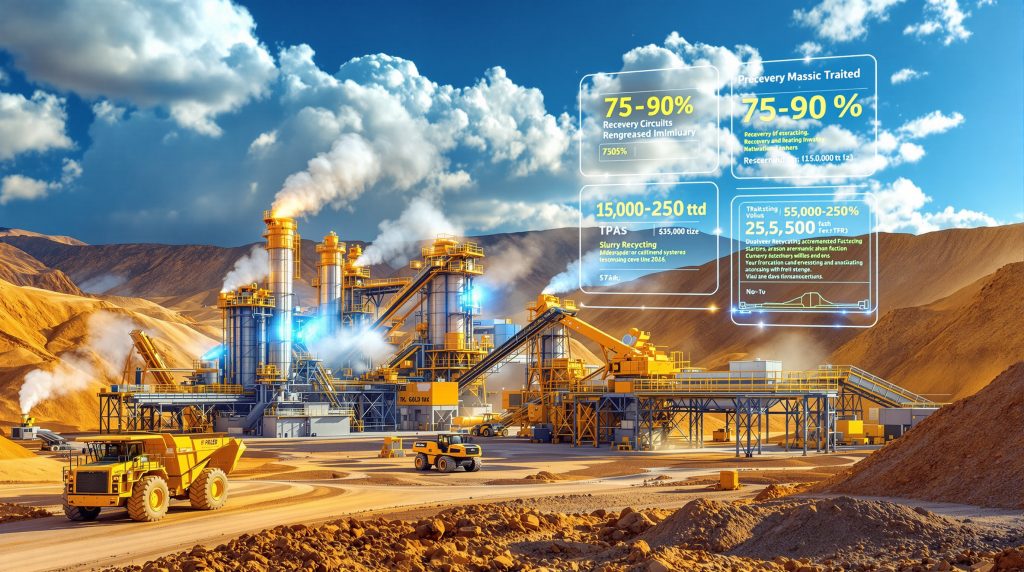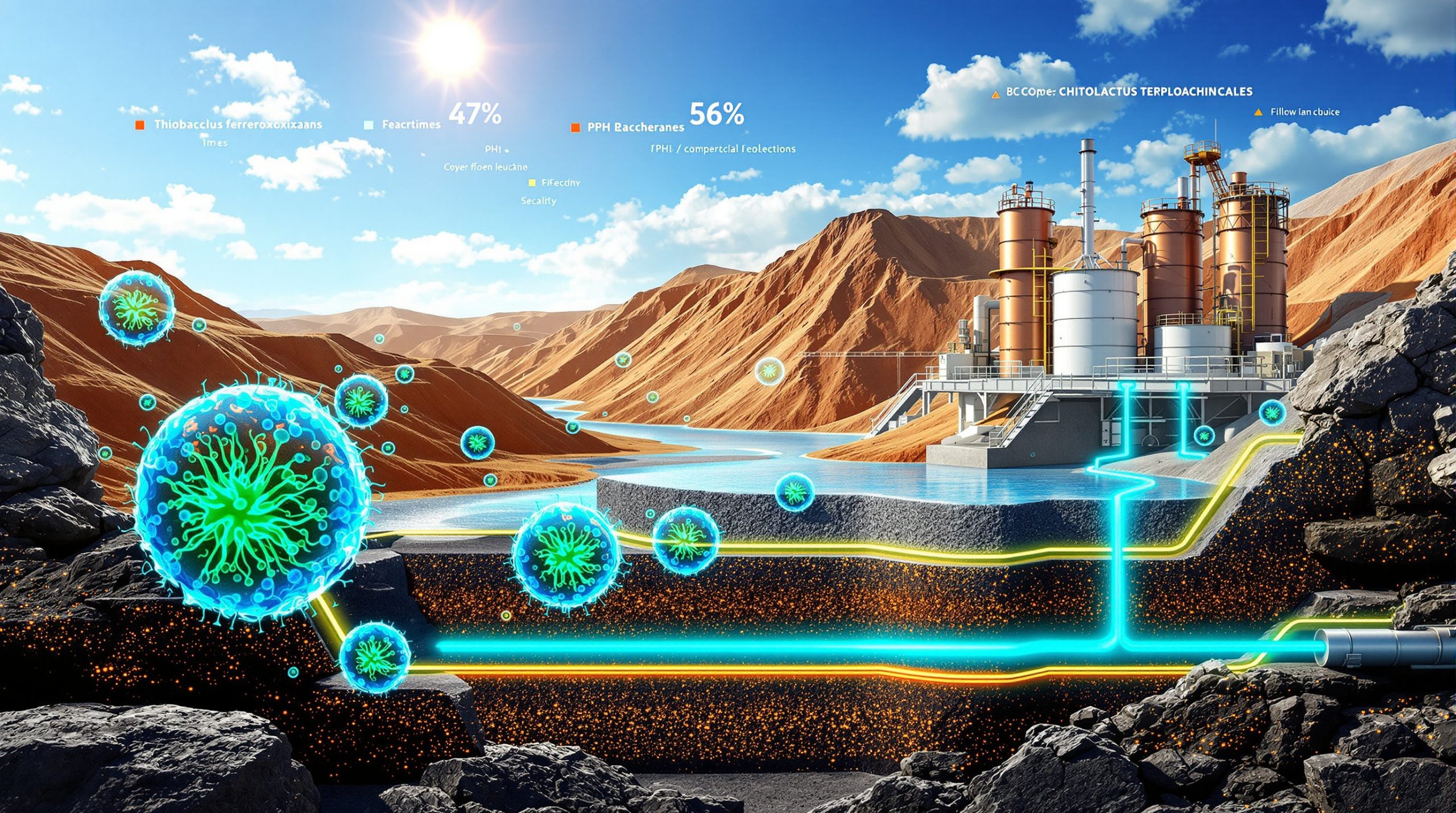Revolutionary Processing Technology Transforms Century-Old Mining Waste Into Economic Gold Production
The mining industry faces unprecedented pressure to address historical environmental liabilities while maintaining profitable operations in an era of resource scarcity. Advanced tailings processing technologies have emerged as the critical bridge between environmental restoration and economic value creation, enabling extraction of precious metals from previously uneconomical waste streams. This technological revolution transforms how the industry approaches resource recovery, turning massive tailings deposits from century-old mining operations into viable production assets through sophisticated engineering systems designed for ultra-low grade material processing.
Modern surface retreatment operations demonstrate remarkable engineering achievements, processing material containing as little as 200 parts per billion gold content while maintaining economic viability. These operations require fundamental shifts in processing philosophy, moving from traditional high-grade, low-volume models to mega-volume, nano-recovery approaches that process enormous quantities of historical waste material to extract economically viable precious metals.
Economic Foundations of Large-Scale Tailings Processing
The DRDGOLD surface tailings retreatment model exemplifies how economic viability emerges from processing massive throughput volumes to compensate for ultra-low grade material. Operating within a 150-kilometre radius containing 140 years of concentrated gold mining history in South Africa's Witwatersrand Basin, DRDGOLD's Ergo operations have demonstrated that systematic processing of historical mining waste can generate substantial shareholder returns while simultaneously addressing environmental restoration challenges.
Financial Performance Metrics:
- Market capitalisation growth to approximately US$2 billion
- 18 consecutive years of dividend payments despite ultra-low grade processing
- Capital expenditure commitment of approximately 10 billion rand over recent years
- Forward capital planning of 8 billion rand over next three years
- Infrastructure designed for 20-40+ year operational lifespans
The economic model depends on continuous 24-hour operations to maximise asset utilisation across processing facilities designed to handle extreme volumes. Unlike traditional underground mining operations requiring extensive development capital, surface tailings retreatment leverages existing waste materials and infrastructure, focusing capital allocation on processing plant technology, slurry transport systems, and long-term tailings storage facilities rather than mine development expenditure.
Blended Material Optimisation Strategy
Rather than maximising short-term profits by processing only the highest-grade available material, successful operations implement blended material strategies to optimise long-term resource extraction. This approach maintains sustainable operations over decades while supporting consistent dividend policies and internal financing of major capital projects through tailings economic models.
Gold price sensitivity creates significant operational leverage for tailings retreatment operations. Current pricing around 2.2 million rand per kilogram represents substantial improvement from historical planning assumptions of 600,000 rand per kilogram, demonstrating how favourable commodity cycles enhance project economics while requiring disciplined cost management to maintain viability during potential price corrections.
Advanced Processing Technologies for Ultra-Low Grade Recovery
Contemporary tailings retreatment employs sophisticated multi-stage processing chains optimised for fine particle recovery from oxidised waste material. These systems achieve 75-90% gold recovery from tailings material that previously yielded 40-60% recovery rates, representing a fundamental advancement in mineral processing capabilities.
Processing Performance Optimisation:
| Processing Stage | Technology Application | Recovery Contribution |
|---|---|---|
| Primary Screening | Vibrating screens, cyclones | 15-20% of total recovery |
| Flotation Circuit | Specialised reagent programmes | 40-50% of total recovery |
| Gravity Recovery | Spirals, shaking tables | 20-25% of total recovery |
| Final Concentration | Magnetic separation, leaching | 10-15% of total recovery |
Critical Operational Parameters:
- Slurry density control: 35-45% solids content optimisation
- Grinding circuit efficiency: P80 target of 75-100 microns
- Flotation residence time: 8-12 minutes per cell bank
- Recovery monitoring: Real-time grade control systems
The technological advancement centres on particle size optimisation through controlled grinding, chemical treatment protocols tailored to oxidised tailings characteristics, and multi-pass processing systems designed to capture previously unrecoverable gold particles. Real-time process control maintains optimal operating parameters across complex processing chains handling enormous material volumes with minimal margin for operational error.
Recovery Rate Enhancement Mechanisms:
- Ultrafine grinding circuits to liberate encapsulated gold particles
- Enhanced flotation processes with specialised reagent programmes
- Gravity concentration systems for coarse gold recovery
- Advanced screening and classification to separate recoverable fractions
Infrastructure Systems Supporting Mega-Volume Operations
Successful tailings retreatment requires sophisticated material handling infrastructure designed to transport and process enormous quantities of waste material continuously. These systems integrate environmental protection measures with operational efficiency requirements, creating complex engineering solutions for sustainable large-scale operations through infrastructure engineering.
Integrated Transport Networks:
- Dual pipeline systems separating slurry transport and water return flows
- Pressurised pumping stations maintaining continuous material flow
- Automated control systems monitoring flow rates and densities
- Emergency backup systems ensuring operational continuity
The infrastructure approach integrates environmental considerations from the planning stage rather than treating them as compliance additions. Double pipeline arrangements minimise portable water usage in water-scarce regions, while these upfront capital investments reduce ongoing operational costs and environmental impact simultaneously.
Processing Plant Engineering Specifications:
- Modular processing units enabling cost-effective capacity expansion
- Redundant equipment systems minimising downtime risks
- Environmental containment systems preventing contamination
- Quality control laboratories monitoring recovery performance continuously
Long-term infrastructure planning reflects operational horizons spanning multiple commodity price cycles, informing decisions about redundancy levels, environmental containment systems, and quality control capabilities. This strategic approach enables infrastructure built today to support operations across 20-40+ year periods while maintaining economic viability during varying market conditions.
Environmental Remediation Integration Creating Operational Value
The integration of gold recovery with environmental restoration creates unique operational value propositions that differentiate surface tailings retreatment from traditional mining operations. This approach transforms environmental liabilities into economic opportunities through systematic processing and rehabilitation protocols utilising environmental restoration strategies.
Simultaneous Processing and Site Rehabilitation:
- Systematic tailings removal following engineered sequences
- Contaminated soil treatment during material handling operations
- Groundwater protection through liner systems and continuous monitoring
- Progressive rehabilitation of cleared areas for future beneficial land use
Furthermore, environmental restoration serves as the fundamental business model component rather than supplementary compliance activity. The approach addresses 130+ years of mining activity legacy while generating economic returns from material previously considered waste. This integration creates authentic environmental value proposition predating recent ESG investment trends and providing competitive advantages as sustainability standards evolve globally.
Waste Management Optimisation Systems:
- Reduced final waste volumes through enhanced recovery processes
- Improved tailings stability in new storage facilities
- Water recycling systems minimising fresh water consumption
- Dust suppression protocols protecting surrounding communities
Operational Challenges in Surface Tailings Processing
Processing historical tailings presents unique technical challenges requiring sophisticated management approaches to maintain consistent performance across ultra-low grade material streams. These operational challenges demand specialised expertise and continuous system optimisation to achieve economic viability.
Material Variability Management
The inherent variability in historical tailings material creates significant operational challenges. Feed grade consistency requires sophisticated blending protocols, stockpile management systems, and quality assurance testing to monitor material characteristics continuously. Seasonal adjustments account for weather-related variations affecting material handling and processing efficiency.
Equipment Wear and Maintenance Protocols:
- Abrasive material handling requiring specialised equipment design
- Predictive maintenance programmes minimising unplanned downtime
- Component lifecycle management optimising replacement schedules
- Spare parts inventory ensuring rapid repair capabilities
However, for operations dependent on mega volumes, tonnage fluctuations significantly affect cost profiles. System stability becomes critical when processing 200 parts per billion gold content, creating minimal margins for operational error. The operational complexity of running continuous 24-hour operations delivering required tonnage to multiple processing plants simultaneously demands sophisticated logistics coordination.
Water Management in Tailings Retreatment Operations
Water scarcity in mining regions necessitates sophisticated water management systems achieving high recycling rates while meeting environmental protection standards. These closed-loop systems represent critical infrastructure components enabling sustainable large-scale operations in water-constrained environments.
Water Balance Optimisation Metrics:
- Process water recycling: 85-90% reuse rates from recycling systems
- Thickener systems: Maximising water recovery from tailings
- Evaporation pond management: Controlling excess water volumes
- Quality monitoring: Ensuring process water specifications
Environmental Protection Infrastructure:
- Lined storage facilities preventing groundwater contamination
- Storm water management controlling surface runoff
- Water treatment systems meeting discharge standards
- Emergency response protocols addressing potential spills
In addition, the water management approach integrates operational efficiency with environmental protection through sophisticated recycling systems that reduce both operational costs and environmental impact. These systems enable operations in water-scarce regions while maintaining regulatory compliance and community relations.
Modern Tailings Storage Facility Engineering
Contemporary tailings storage incorporates advanced engineering principles designed to support long-term operations while ensuring structural integrity and environmental protection throughout operational lifecycles extending multiple decades.
Structural Design Features:
- Upstream construction methods optimising stability characteristics
- Engineered liner systems preventing seepage into groundwater
- Drainage collection systems managing pore water pressure
- Monitoring instrumentation tracking structural performance continuously
Safety and Compliance Framework:
- Dam safety inspections following international engineering standards
- Emergency action plans addressing potential failure scenarios
- Community engagement protocols ensuring stakeholder communication
- Regulatory compliance monitoring meeting environmental requirements
Economic Performance Metrics for Tailings Retreatment
Successful tailings retreatment operations demonstrate specific performance characteristics that differentiate them from traditional mining operations while creating measurable economic value through ultra-low grade material processing.
Key Performance Indicator Benchmarks:
| Metric Category | Measurement Parameter | Industry Target Range |
|---|---|---|
| Processing Efficiency | Tonnes processed daily | 15,000-25,000 tpd |
| Recovery Performance | Gold recovery percentage | 75-90% |
| Operating Costs | Cost per tonne processed | $8-15/tonne |
| Environmental Impact | Water usage per tonne | 0.5-1.0 m³/tonne |
Financial Performance Drivers:
- Throughput optimisation: Maximising plant utilisation rates across continuous operations
- Recovery enhancement: Improving gold extraction efficiency through process optimisation
- Cost control: Managing operating expenses per unit processed
- Capital efficiency: Optimising infrastructure investment returns over extended operational periods
Regulatory Framework Impact on Operations
Surface tailings processing operates under comprehensive regulatory oversight requiring integrated compliance across multiple regulatory domains. These frameworks shape operational design and ongoing management practices while creating both constraints and opportunities for industry participants.
Environmental Regulatory Requirements:
- Water use licences governing consumption and discharge parameters
- Air quality permits controlling dust emissions and atmospheric impacts
- Waste management approvals for tailings storage and handling
- Biodiversity impact assessments protecting local ecosystem integrity
Mining Rights and Operational Permits:
- Surface rights acquisition for tailings access and processing
- Processing permits authorising treatment activities
- Transportation licences for material movement and logistics
- Closure planning requirements ensuring long-term rehabilitation funding
Technology Innovation Advancing Industry Capabilities
Emerging technologies continue advancing tailings retreatment capabilities through sensor-based systems, automated process control, and environmental integration technologies that enhance both operational efficiency and environmental performance.
Emerging Processing Technologies:
- Sensor-based sorting improving feed grade consistency
- Advanced flotation cells enhancing fine particle recovery
- Automated process control optimising real-time performance
- Predictive maintenance systems reducing equipment downtime
Environmental Technology Integration:
- Renewable energy systems reducing operational carbon footprint
- Advanced water treatment enabling higher recycling rates
- Biogeochemical treatment neutralising acid mine drainage
- Remote monitoring systems ensuring continuous environmental compliance
Market Positioning and Competitive Dynamics
Surface tailings retreatment operations demonstrate significant leverage to gold price movements due to ultra-low grade material processing characteristics, while creating competitive advantages through environmental value propositions and reduced capital intensity compared to traditional mining development.
Gold Price Sensitivity Analysis
Operations processing 200 parts per billion material show substantial margin expansion with favourable commodity pricing. Current gold prices around 2.2 million rand per kilogram compared to historical planning assumptions of 600,000 rand per kilogram demonstrate the operational leverage inherent in ultra-low grade processing models.
Competitive Advantage Framework:
- Lower capital intensity compared to greenfield mining projects
- Shorter development timelines leveraging existing infrastructure
- Reduced exploration risk with quantified resource inventories
- Environmental value proposition addressing legacy mining impacts
Consequently, the global mining industry faces mounting pressure to address historical environmental liabilities as regulatory frameworks tighten and stakeholder expectations evolve. Surface tailings retreatment provides solutions that transform century-old mining waste into economic production while permanently remediating environmental damage, creating value propositions increasingly relevant as major mining companies hold significant tailings liabilities with limited expertise in economic retreatment methodologies.
Market Expansion Opportunities
The proven DRDGOLD surface tailings retreatment model demonstrates replicability potential across multiple jurisdictions and potentially other metals including copper. According to recent analyses of tailings transformation opportunities, geographic expansion strategies vary by jurisdiction, with full ownership models preferred in familiar territories while partnership approaches enable market entry in unfamiliar jurisdictions through established operator collaboration.
This technological revolution in mining waste processing represents fundamental industry evolution, demonstrating that environmental restoration and economic value creation can operate as integrated business models rather than competing priorities. As global mining operations grapple with increasing environmental obligations and resource depletion challenges, surface tailings retreatment technologies provide proven pathways for transforming historical liabilities into contemporary opportunities.
Ready to Invest in the Next Major Mineral Discovery?
Discovery Alert instantly alerts investors to significant ASX mineral discoveries using its proprietary Discovery IQ model, turning complex mineral data into actionable insights. Begin your 30-day free trial today to position yourself ahead of the market, and explore why historic discoveries can generate substantial returns by understanding the potential of breakthrough mining technologies.




